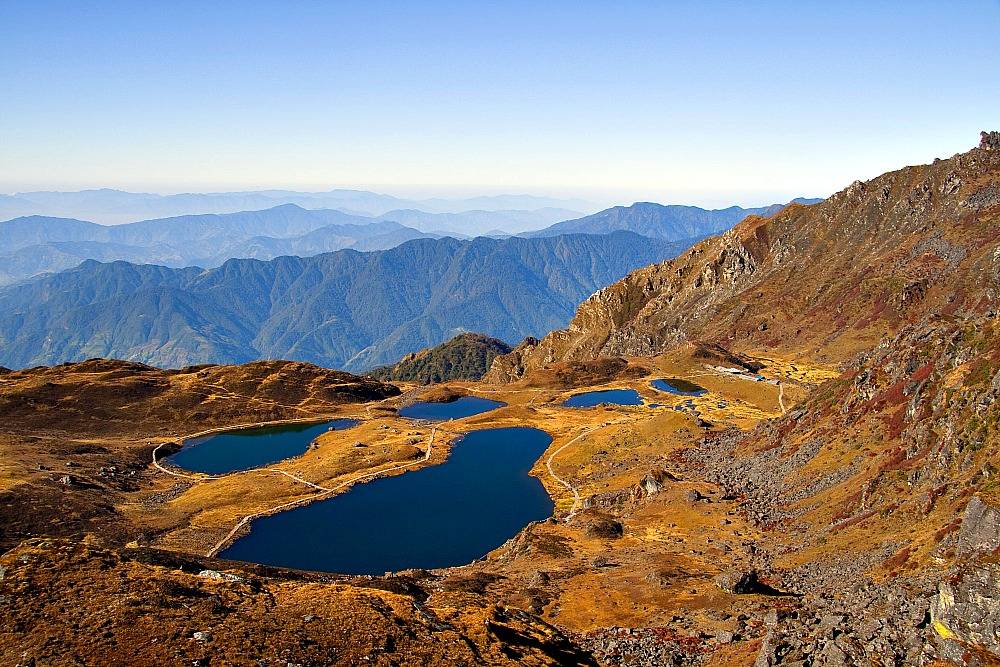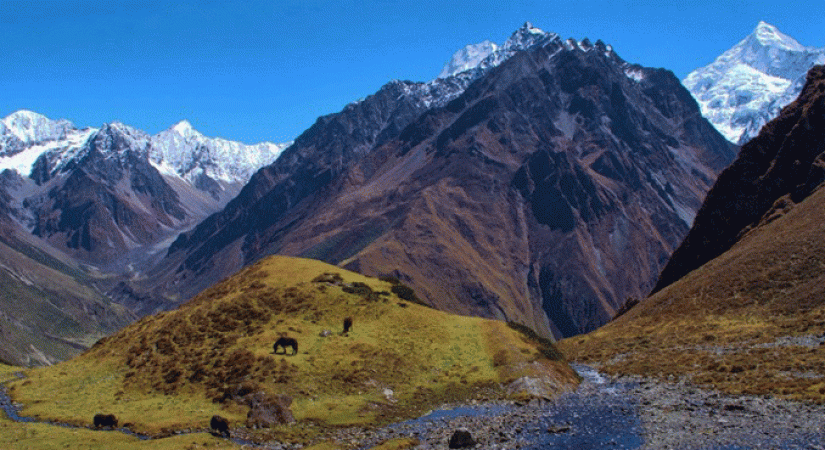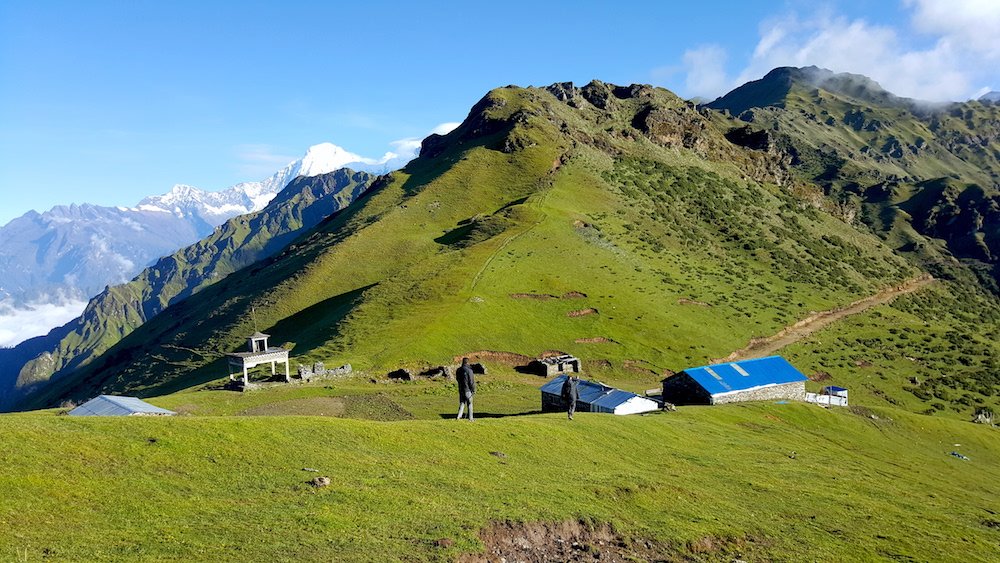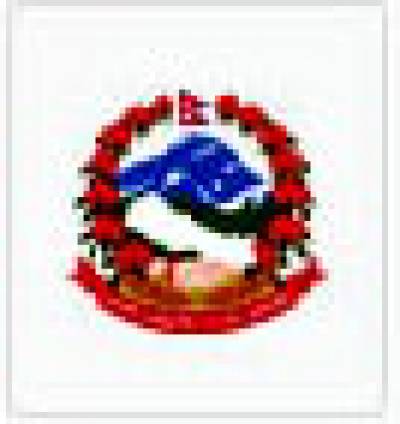PANCH POKHARI TREK - 14 DAYS
A SENSORY AWAKENING – VISUALLY AND SPIRITUALLY!
THIS IS A NEW & EXCITING DESTINATION WITH FANTASTIC MOUNTAIN VIEWS & TREK TO FIVE PRISTINE ALPINE LAKES. FOLLOW IN THE FOOTSTEPS OF LORD SHIVA!
The Panch Pokhari (five lakes) trek is rich in historical significance. It is a place where the Hindu god Lord Shiva thrust his Trishul (holy Trident) into a mountain to extract water so that he could cool his stinging throat after he had swallowed poison. The waters of Lake Gosainkunda are considered holy and of particular significance during the Gangadashahara and the Janai Purnima festivals when thousands of pilgrims from Nepal and India visit the area.
On this trek, you will have some of the most spectacular views found anywhere in Nepal, such as Madiya Peak (6799m) Dorje Lakpa (6966m), Phurbi Chhyachu (6658m), Jugal Himal (mountain range), and views over the Rolwaling and Langtang regions.
This is a cultural awakening trip through Sherpa and Tamang settlements and the opportunity to better understand how and why these villagers survive in these remote locations. Their Buddhist faith is clearly expressed on their genuine smiling faces and hospitality.
Besides Gosainkunda Lake, there are fantastic views of snow-capped mountains, glaciers and unique wildlife. The Langtang National Park is 25% forest ranging from subtropical to alpine and includes deciduous oak and maple, pine, and rhododendron (in full bloom in spring). The trail passes through bamboo groves and alpine forests, and if luck has it you will also see the somewhat elusive red panda, or maybe the Himalayan black bear, Himalayan Tahr and rhesus monkeys. The birdlife is also abundant in this region. It is rumored that the fabled Yeti has been seen here too!
A reasonable level of fitness is required on this trek due to climbing at higher altitudes. This is a year-round trek.
Key Features of Panch Pokhari Trek
- Panch Pokhari (Panch means ‘five’ and Pokhari means ‘lake’ (hence the name of this trek as five holy lakes).
- Subtropical forest and alpine rugged terrain.
- Rhododendron forests – especially beautiful in spring when in full bloom (Nepal’s national flower)
- Rich cultural traditions, dress and Buddhism of the Tamang people.
- Jugal Himal (mountain range), Rolwaling range, Gosainkunda Lakes & Jugal Himal range.
- The highest point of the trek 4100 meters (Panch Pokhari)
- Fewer tourists and an abundance of peace and quiet.
- Witness unique wildlife and beautiful fauna and flora – meerkats, red panda.
- Explore the Langtang National Park.
ITINERARY
Day 1 : Arrival in Kathmandu and transfer to hotel.
Upon arrival at Kathmandu Airport you will be met by Sherpa Expedition and Trekking staff and transported to your hotel, followed by a short briefing concerning your trek.
Day 2 : Drive from Kathmandu to Chautara (1,200m) Duration: 6-7 hours.
Our journey begins with a road trip along the Araniko Highway to the district center of the Sindhupalchok district – Chautara Village. From our campsite at Chautara are views over a lush forest and of terraced slopes where villagers grow staple crops. A very peaceful place to stay for the night.
Day 3 : Trek from Chautara to Phusre (2,045m) Duration: 5-6 hours.
Our trek begins as we set off through the valley and pass many villages of various ethnicities. The various castes in the villages highlight the peaceful co-existence of people in these regions. We then ascend, crossing small rivers with the ever-present terraced farmland on the hillsides until we reach our campsite at Phusre where we stay the night.
Day 4 : Trek from Phurse to Kami kharka (2,845m) Duration: 6-7 hours.
We start today with an hour-long uphill trek from Phusre to Thulo Okhareni. Then trail keeps heading uphill for about four hours passing through rhododendron and pine forests. The trail in this area is abundant with birdlife and other animals, especially the Danphe (pheasant), the national bird of Nepal. The trail becomes less physically demanding and then we find ourselves in summer pasture-land where we make camp for the night.
Day 5 : Trek from Kami Kharka to Pauwa Bas (3,000m) Duration: 5-6 hours.
The trek today is quite easy and passes through a peaceful region of juniper, oak, pine and rhododendron forests. After some time we can see the houses of the nomadic cattle herders. Tonight we make camp and stay in a tent at Pauwa Bas.
Day 6 : Trek from Pauwa Bas to Hille Bhanjyang (3,400m) Duration: 5-6 hours.
A more demanding trek today as we ascend for about 3 hours to the top of a hill and then have a steep descent for around one and half hours, during which time we will have some mesmerizing views of the surrounding mountains. We finally arrive at Hile Bhanjyang where we tonight stay in a lodge.
Day 7 : Trek from Hille Bhanjyang to Nasim Pati (3,700m) Duration: 5-6 hours.
The trek begins with a steep ascent for about an hour. Once at the top of the hill you are rewarded with some majestic panoramic views in every direction. We then descend for about three hours passing through rhododendron forests and across a rocky landscape before reaching a traditional pilgrims stop-over point at Nasim Pati where we stay overnight in a tent.
Day 8 : Trek from Nasim Patito Panch pokhari (five lakes) (4,100m) Duration: 5-6 hours.
The trek today is quite physically demanding as we ascend to higher altitudes over rocky hillsides before reaching the holy Hindu five lakes - Panch Pokhari. Pilgrims from all over Nepal and India make pilgrimage here and stay in several of the small huts surrounding the lakes. We have time to explore the area around the lakes and reflect on life and the special significance of this holy place. We stay here overnight in a tent.
Day 9 : Trek from Panch pokhari to Nasimpati (3,700m) Duration: 6-7 hours.
We have an early start today. From Panch Pokhari we have extensive views of Mt. Dorje Lakpa, Jugal Himal Range, Rolwaling Range and Langtang Ranges. After packing up our gear we descend down the steep trail back through the rhododendron forest to Nasim Pati where we camp overnight.
Day 10 : Trek from Nasimpati to Dukang (2,100m) Duration: 5-6 hours.
Today we initially have a steep descent before it becomes flatter and less physically demanding as we pass through terraced hillsides and look down into deep gorges. We soon reach the authentic Tamang village at Dukang. This is an excellent place to explore and admire the Tamang people and their traditions. The architecture here is unique and highlights how they have maintained their tradition in the new world. Tonight we stay in a tent.
Day 11 : Trek from Dukang to Dhap (1,200m) Duration: 5-6 hours.
Once again we have a steep descent before leveling off a little, following the trail through the terraced farmlands and with views down into the gorges. We then arrive at the Tamang village of Dhap. This is another opportunity to further your understanding of who and what the Tamang people believe and how it influences their daily lives. We stay overnight here in a tent.
Day 12 : Trek from Dhap to Melamchipul Bazaar and drive to Kathmandu; Duration: 6-7 hours.
This is our last day on the trail and we head to Kathmandu by bus.
Day 13 : Kathmandu Valley sightseeing.
At about 8.30 am, after a healthy breakfast, your sightseeing trip begins and takes you to several cultural sites and places of historic interest in the Kathmandu Valley. A private car and guide will lead the way!
Day 14 : Final departure day
Today Sherpa Expedition and Trekking will take you to the airport about 3 hours prior to departure. You will take with you some unforgettable memories of Nepal and on your flight home think about your next journey into the amazing Himalayas.
SERVICES
Costs Included In Your Package
- Airport picks up and transports by private Car/Jeep.
- Three Night's hotel accommodation In Kathmandu with breakfast (3 star Hotel)
- Transportation from Kathmandu to Chautara via public bus.
- Melamchi to kathmandu transportation by Jeep/Car
- All standard meals (lunch, dinners & breakfast) during the trek.
- Best possible teahouses, lodge accommodation (generally twin share rooms)- during the trek
- Government licensed holder English speaking trek leader (10 or more trekkers an assistant guide) and porter to help carry your luggage.
- Strong, helpful Sherpa porters with proper safety equipment and walking equipment, his salary, food, accommodation, and insurance (one porter for two people).
- Required staff such as kitchen boy, dishwasher entire the trip
- Kitchen types of equipment, trekking types of equipment and tents (two men tent, kitchen tents, etc), mattress during the tented accommodation as mentioned in the itinerary
- Kathmandu valley sightseeing by private car or jeep.
- Guides and porters provided by Sherpa Trekking & Expeditions, including their meals, insurance, salary, lodging, transportation, and other necessary equipment
- All the required permits and paper works
- All government, local taxes, and official expenses
- Assistance in arranging rescue operations in case of complicated health conditions such as altitude sickness (funded by travel insurance)
- Souvenir - Sherpa Trekking & Expeditions t-shirt
- Use of sleeping bag, down jacket, duffel bag, and walking poles (if you don’t have your own, to be returned after the trip is completed).
- Sherpa Expedition and Trekking’s certificate of appreciation & completion after the successful trek
- Oxygen meter to check your pulse and oxygen saturation and heart rate twice daily (Very useful to check Altitude Mountain Sickness(AMS) symptoms) which will ensure your health during the trek.
Costs Exclude
- International airfares
- Nepal entry visa fee (easy to obtain the visa on arrival at Tribhuvan International Airport – Kathmandu). $30 USD for 15-day, $50 USD for 30 Days, and $125 USD for 90 Days visa.
- Extra night’s accommodation in Kathmandu due to early arrival or late departure or early return from the trek.
- All the alcoholic and nonalcoholic, soup, tea, coffee, hot chocolate, cocoa, mineral water, extra food, cold and hot drinks on trek ( i.e. those you choose to purchase along the way and during evenings in the tea houses)
- All desserts & sweet things like chocolate, cake, pie, pudding.
- Hot shower and battery charging at the tea houses.
- Lunch and dinner in Kathmandu
- Personal clothing and gear
- Kathmandu valley sightseeing entrance fee $30
- Travel insurance which has to cover emergency high-altitude rescue and evacuation (compulsory)
- Tips for guide and porters (recommended in our culture – and well deserved too!)
- Additional costs or delays caused by events beyond our control, for example, landslides, severe weather conditions, itinerary modification due to safety concerns, illness, change of government policies & strikes.
- All the costs and expenses which are not listed in "costs include" will be counted as exclusions.
EQUIPMENTS
The following information will give you some idea about what you need to bring for the trek. It is important you do not forget the essential items, as this will determine your comfort and safety on the trek. Equally important is that you do not burden yourself with unnecessary equipment on the trek.
- Sleeping Bag (Sherpa Teams will provide but need to return after completing the trip)
- Duffel Bag (Sherpa Teams will provide but need to return after completing the trip)
- Fleece jacket or pullover
- Waterproof windbreaker or windcheater
- Thermal underclothes
- Rain poncho
- Down jacket (Sherpa Teams will provide but need to return after completing the trip)
- Fleece or wool trousers
- Sun hat or scarf
- Trekking pants (two pairs)
- Mittens or woolen gloves
- Hiking socks (several pairs)
- Moisture-wicking shirts, including t-shirts
- Trekking shoes or boots with spare laces
- Flip-flops or sandals for relaxing in the evenings
- Underwear (several pairs)
- Swimsuit or swimming costume
- Sunglasses
- Headlamp or flashlight/torch
- Sleeping bag (Sherpa Teams can provide this for you)
- Trekking poles (if desired)
- Hiking backpack with a capacity of at least 40 liters
- Small lock for your backpack
- Reusable water bottles (at least two liters)
- Water purification tablets or filtration device
- Wash towel
- Basic first aid kit
Toiletries (tissues, toilet paper, moisturizer, lip balm, sunscreen, sanitary pads, hand sanitizer, nail clippers, a small mirror, toothbrush, toothpaste, glasses, contacts, etc.)
GOOD TO KNOW
Accommodation
You will be accommodated in 3-star hotels in Kathmandu. During the trek, we will be staying at lodges/ teahouses. You may find comfortable and better quality teahouses. During the trek, you will be staying in a tent.
Meals during the trek
In Kathmandu, your hotel includes breakfast, whereas all meals (breakfast, lunch, and dinner) will be provided during the trek. A staple food of these regions is potatoes, oats, buckwheat, Sherpa stew, and Tibetan bread. Sherpa’s’ started farming potatoes when the first seeds were introduced to the region in the early 90s. There is a limited choice of food at higher elevations and except many potato dishes. Potatoes are high in carbohydrates – an excellent source of energy needed at high altitudes.
Transportation
We use a private car for sightseeing and for the airport to hotel pick and drop off. We use public transportation or local buses during the trek.
Physical fitness
This can be a challenging trek where you often have to walk 6-7 hours a day. You need past experience of hiking or trekking but if you have done any kind of trekking activities then it is always a plus! We have met people from all walks of life, shapes, and sizes who have completed the trek. The only difficult part is when altitude sickness strikes and the effect that it can have on your body. Before leaving for Nepal it is good if you can prepare yourself physically by increasing your stamina and oxygen intake.
Remember – The better prepared – the more enjoyable your trek!
MAP
PHOTOS/Videos
Departures
Select a departure month
Fill out the form below and a Travel Expert will reach out to create your perfect tour.
FAQS
What is the duration of the Panch Pokhari Trek?
The Panch Pokhari Trek usually takes around 10-12 days to complete, depending on the itinerary and trekking pace.
How difficult is the Panch Pokhari Trek?
The trek is considered moderately challenging. It involves some steep ascents and descents, as well as high altitude trekking. Prior trekking experience and a good level of fitness are recommended.
When is the best time to do the Panch Pokhari Trek?
The best time to do the trek is during the spring (March to May) and autumn (September to November) seasons when the weather is favorable and the views are clear.
Do I need a permit for the Panch Pokhari Trek?
Yes, a permit is required for the Panch Pokhari Trek. You need to obtain the Langtang National Park Entry Permit and the TIMS (Trekkers' Information Management System) card.
Is it possible to do the trek independently or do I need a guide?
It is possible to do the trek independently, but having a guide is recommended for safety and navigation purposes, especially if you are not familiar with the area.
Are there tea houses or lodges along the trekking route?
Yes, there are tea houses and lodges available along the trekking route where you can find accommodation and meals. However, the facilities may be basic compared to more popular trekking regions.
What kind of accommodation can I expect during the trek?
Accommodation during the trek is basic, with shared rooms and common toilets. The tea houses and lodges provide clean and comfortable beds with blankets.
What kind of food is available during the trek?
The tea houses and lodges offer a variety of meals, including Nepali, Tibetan, and international cuisines. You can expect rice, noodles, vegetables, meat, and soups.
What is the maximum altitude reached during the Panch Pokhari Trek?
The highest point of the Panch Pokhari Trek is the Panch Pokhari Pass, which stands at an altitude of around 4,100 meters.
Is it safe to drink water during the trek?
It is advisable to drink bottled or purified water during the trek to avoid any risk of waterborne diseases. You can buy bottled water or use water purification tablets.
Are there any communication facilities available during the trek?
There may be limited communication facilities available in some tea houses along the trekking route. However, it is recommended to carry a local SIM card for better connectivity.
Is travel insurance necessary for the trek?
Yes, it is highly recommended to have travel insurance that covers emergency medical evacuation, trip cancellation, and personal belongings.
What are some other highlights of the Panch Pokhari Trek?
Apart from the pristine lakes of Panch Pokhari, the trek offers breathtaking views of the Langtang Himalayan range, an opportunity to experience the local Tamang and Sherpa cultures, and the chance to witness diverse flora and fauna in the Langtang National Park.
What is the starting point of the Panch Pokhari Trek?
The trek usually starts from Chautara, which is around a 5-6 hour drive from Kathmandu.
Is there any altitude sickness risk during the Panch Pokhari Trek?
Altitude sickness can be a risk during the trek, especially when crossing the Panch Pokhari Pass. It is important to acclimatize properly, stay hydrated, and listen to your body's signals.
Latest Traveller’s Reviews
Travel experiences of our clients who recently returned from their trips.
100%
Based On 7 Reviews
Catherine Chola
Netherlands
December 21, 2023
An off-the-beaten-path gem
The Panch Pokhari Trek is a hidden gem in the Langtang region. Away from the crowds, this trek offers a unique and authentic experience of the Himalayas. The pristine lakes, breathtaking views, and peaceful surroundings make it a trek worth exploring.
John David
Austria
November 23, 2023
An opportunity for cultural immersion
The Panch Pokhari Trek allowed us to interact with the local communities and learn about their unique culture and way of life. From staying in teahouses run by locals to witnessing traditional ceremonies and festivals, we felt a deep connection to the rich cultural heritage of the region.
Farhad Faridpanah
United States
November 22, 2023
A spiritual journey
Panch Pokhari holds great religious significance for both Hindus and Buddhists. Trekking to these sacred lakes was not only a physical adventure but also a spiritual journey. The serene surroundings and the peaceful aura of the lakes provided a sense of tranquility and introspection.
People Considering This Package Right Now Check availability
























